Abstract
This two-year project focused on obtaining travel behavior data
that more truly reflected underlying behavior. In the first year
of the project a prototype of REACT!, a web-based, self-administered
survey instrument for collecting household travel/activity data was
produced. REACT! documents not only the resultant behavior but also
the scheduling process that produces that behavior by having each
respondent record activities as they are initially planned, updated,
and executed. In the second year, following a beta test of REACT!
and final program modification, a formal REACT! field study was
completed for 47 households who used REACT! to provide 24 hours of
travel/activity data over a 7 day period. Ensuing analyses focused
on the activity scheduling process.
Work Completed to Date
All proposed tasks have been successfully completed (although
continued development and refinement of REACT! continues). The
REACT! software was developed, subject to substantial internal and
beta testing, followed by a full field survey. Formal analysis of
the resulting REACT! data was completed, with results presented at
several conferences and papers being submitted to journals. Results
include the identification of distinct spatial and temporal behaviors
for planned and unplanned activities, with defined gender differences
observed. Classification and structural models were developed to
identify regularities in scheduling behavior. Follow-on research is
focused on integrating REACT! with data from TRACER, a GPS-based
vehicle tracking system, and extending the range of REACT! project
applications.
Key Words: REACT!, household travel/activity surveys,
activity diaries, household activity scheduling, time use.
1. OVERVIEW
The evolving requirements of transportation modeling have created
a greater need for higher quality data on complex travel behavior.
This need has generated an increasing demand for new technologies
and approaches for household activity/travel surveys. Many of the
new technologies, such as the application of Global Positioning
Systems (GPS) and handheld computers to obtain high resolution
travel data, promise to advance existing travel models (and may
even assist in a paradigm shift for travel forecasting). The data,
however, are the outcomes of the decision process, often
termed activity scheduling, that determines when, where, with whom,
and for how long people engage in various activities.
It has been convincingly argued that this decision process is at
the core of travel behavior changes. The effectiveness of policies
such as congestion pricing and travel demand management depends on
how people adjust their daily activity and travel patterns to the
changes being implemented. This process is largely unknown, thus,
additional technologies and approaches need to be directed toward
the in-depth study of this activity scheduling decision process.
An initial step in this direction was CHASE, developed by Sean
Doherty. In response to Doherty's initial experiments with CHASE,
the design of an improved survey technology was launched, with the
goals of automating the initial household interview, reducing
scheduling bias, improving location identification and geo-coding,
automating data transfer, and providing for server-based or
client/server architectures. The result was the REACT! survey
software.
2. The REACT! Survey
A web-based travel/activity survey,
REACT!
is designed as a Computer Aided Self-administered Interview.
REACT! elicits both travel/activity plans as well as revealed
travel patterns as a step toward revealing the household
scheduling process. REACT! comprises two linked components.
The first is the Initial Interview, a
self-administered series of screen interfaces which is completed
the day before the diary period begins. This initial interview
concludes with completion of the first pre-travel survey.
During this phase, all travel and activity that is planned for the
survey period (typically a week) is identified at a level of detail
corresponding to the level of planning -- only those attributes
actually planned are recorded.
The second component is the Daily Interview,
a self-administered survey of the preceding 24 hours of travel and
activity. Planned activities can be moved from the pre-travel plans
to the current day's survey, adding any unplanned characteristics
and updating as necessary. With any Daily Interview, additional
pre-travel planning for the remainder of the week may be recorded.
2.1 The REACT! Initial Interview
The following screen captures depict REACT!'s self-administered
initial interview. These interfaces collect standard demographic
variables (household, person, and vehicle characteristics) as well
as information describing "typical" activity types and locations.
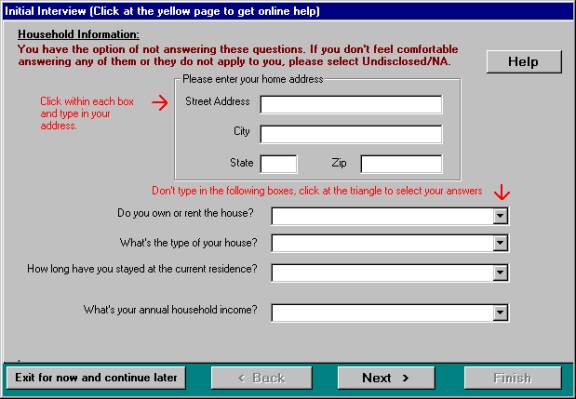 |
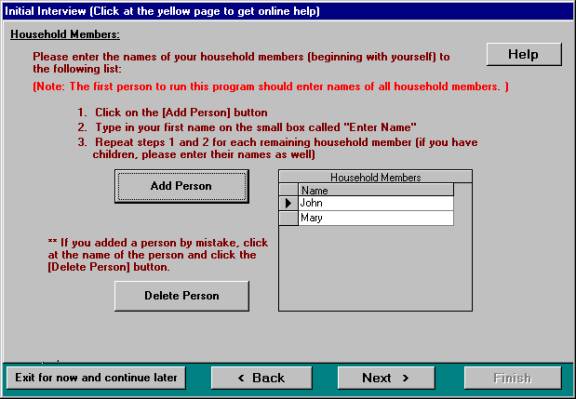 |
| 1. Household Data |
2. Household Members |
|
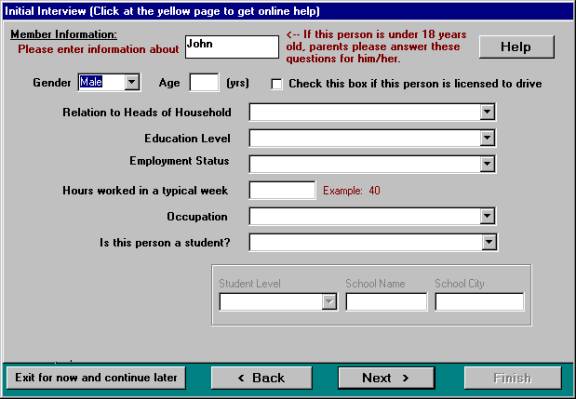 |
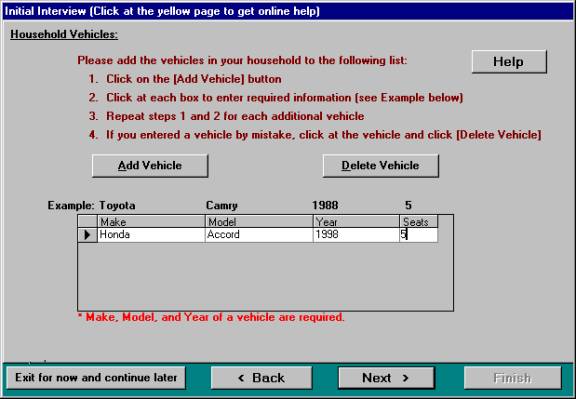 |
| 3. Person Data |
4. Vehicle Data |
|
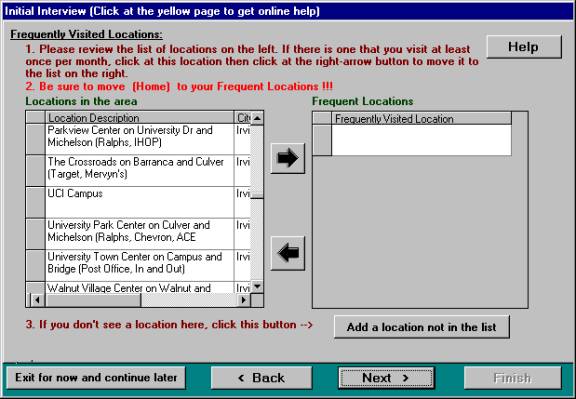 |
 |
| 5. Location Data |
6. GIS Utility |
|
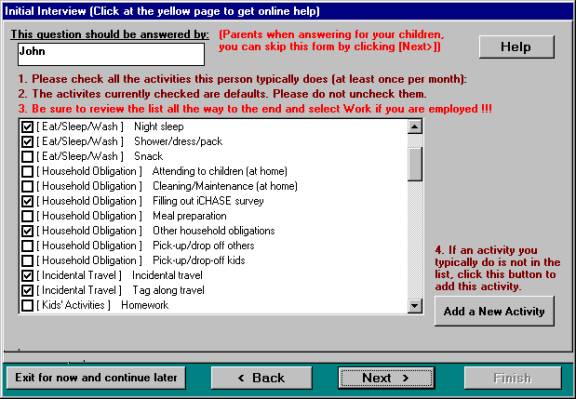 |
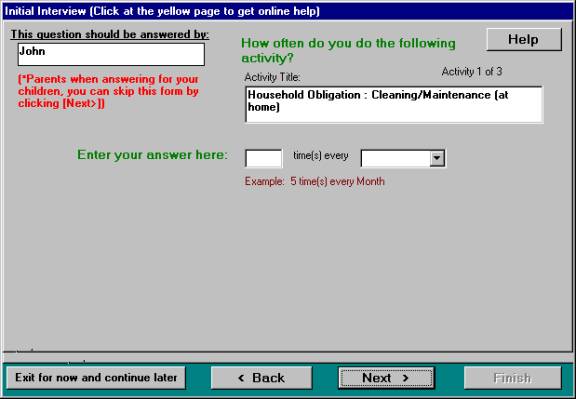 |
| 7. Activity Types |
8. Activity Frequency |
|
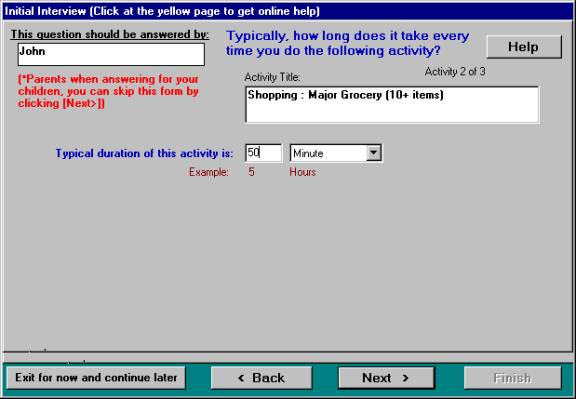 |
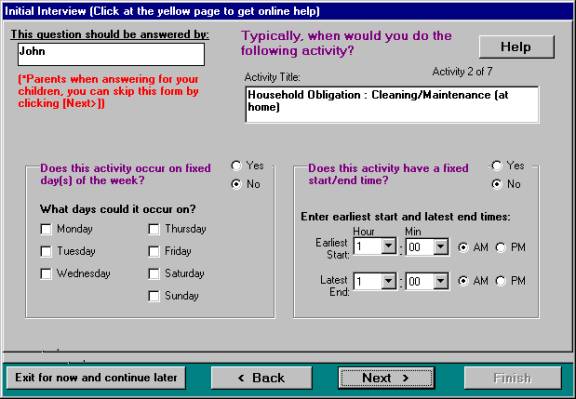 |
| 9. Activity Duration |
10. Activity Scheduling |
|
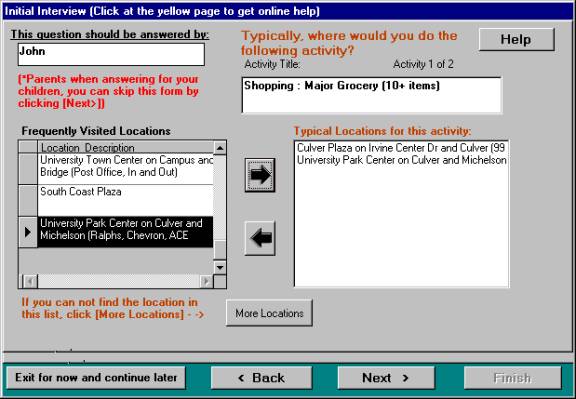 |
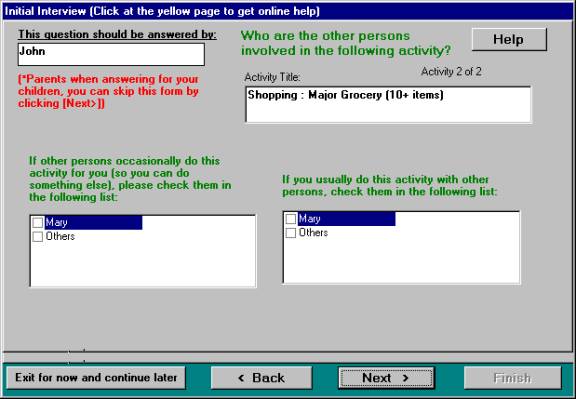 |
| 11. Activity Location |
12. Involved Persons |
|
2.2 The REACT! Daily Planning and Update
The following screen captures illustrate REACT!'s self-administered
daily activity updating and recording. The first interface screen
allows for the recording of planned activities to the degree that
they are planned (the "Anyday" column is used to record activities
when no set day is planned). The second interface screen allows for
the completion of a daily activity schedule via "sliding" planned
activities from the planned day (or from "Anyday") and adding those
details that were not planned (or updating those that have changed).
Every distinct task that you do each day is an activity (whether
it is sleeping, eating, working, picking up your children, watching
TV, seeing a movie, etc.). Before your week starts, you typically
have some of these activities planned to varying degrees. REACT!
incorporates a two-part Activity Diary which records your activities.
First, it records your planned activities for the coming week, then,
as the week proceeds, it will record what you have actually done each
day during the week. Typically, the survey period is a full week,
beginning on a Sunday evening and ending with the next Sunday evening.
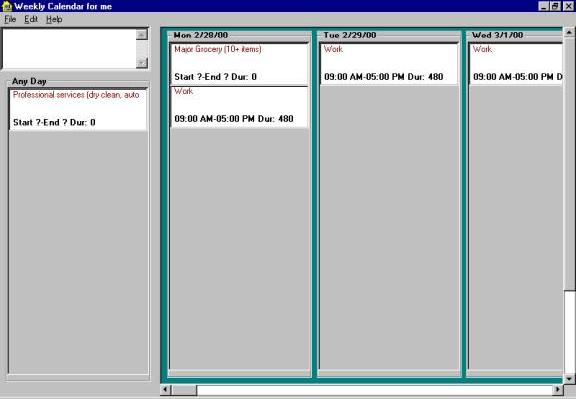
14. Pre-travel Planning
2.3 REACT! Post-travel Activity Updating:
On Monday through Saturday evening REACT! sessions, you will enter
the full details of all activities that you have actually performed
during the day (including in-home activities). You should also enter
any travel (whether walking, biking, or taking a car or bus) completed
in accessing activity locations. REACT!'s second scheduling form, the
Daily Calendar, will be used.
After you have completed your Daily Calendar, you will be taken back to
the Weekly Calendar to review your week's remaining planned activities.
If any of these plans changed (a cancelled or postpones activity, or a
different time or location), or if further activity details have been
determined, update this information. These updates should reflect
changes to your plans but you should not use the REACT! session as a
"Day Planner" to actively develop your plans.
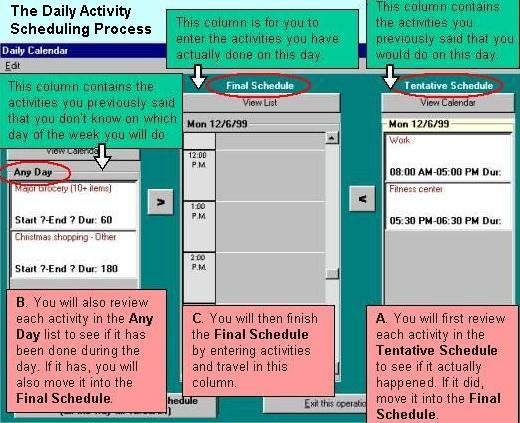
15. Post-travel Updating
2.4 Decision Tracing Dialogs
REACT! is implemented with mechanisms intended to trace decisions
involved in everyday activity scheduling. When a respondent
manipulates a specific activity record in a certain way, a series
of dialog boxes will appear to trace the decision process underlying
the manipulation. These queries appear as soon as respondents change
or add an activity record in their Daily Calendars. Depending on the
response, subsequent dialogs may be triggered to trace the decision
process, including asking whether the respondent thought about the
benefit of the manipulation.
2.5 Filing Daily REACT! Survey Results
When the household is finished recording the daily activity diaries,
the last person is prompted to establish an Internet connection and
activate REACT!'s Send Data utility. In the field test, the program
databases reside on the client end to achieve privacy and efficiency
with a minimum deployment cost. When Send Data is activated, REACT!
compresses the database of the entire household with encryption. The
data package is sent to the survey administrative server via FTP.
The Send Data process is performed automatically without user
intervention and when completed, users are notified to exit REACT!.
[ back to top ]
3. KEY FINDINGS:
The REACT! program was tested in a pilot study in Irvine, California.
Preliminary analyses validate the program's capability of guiding
participants to complete data entry tasks on their own, thus the
initial objective of reducing the resource requirements of such a
computerized survey was achieved. Further, the objectives of
reducing instrumental bias and expanding program capabilities were
also achieved.
3.1 REACT! Technical Performance
A total of 47 households comprising 81 adults participated in a
full week REACT! survey and completed a total of 6738 activities
and 1602 trips. In-home activities comprised 76 percent of the
total activities. No obvious trends exist over the course of the
week for different types of activities, except for the decrease
of work/school activities over the weekend and the increase of
shopping activities on Saturday. On Sunday, respondents finished
their schedules up to the time they ran the program. As for
average number of trips, the most notable fluctuation was the
increase in car trips on Saturday and the decrease in total trips
on Sunday.
The initial, self-administered household interview took 25-45
minutes, depending on household size. Respondents spent between
15 and 20 minutes entering daily activity data and planning
subsequent activity for the week.
Following the survey week, each household was asked to assess,
from a user viewpoint, whether the program design had achieved
its goals. The majority of the responding households indicated
that the program's features did properly convey the survey
designer's instructions.
3.2 REACT! Behavioral Analyses
Data collected with REACT! were used to examine the structure of
activity patterns. The term structure refers to the outcome of a
set of decisions facing individuals as they conduct their daily
activities. At a minimum, structure can be interpreted as the
sequence by which various activities enter one's daily activity
scheduling process.
The analyses validated that the hypothesized "activity-peg"
phenomenon does exist. Two-way contingency tables show that
shorter duration activities were more likely to be inserted
opportunistically in a schedule already anchored by longer
duration counterparts. An analysis of tour structure revealed
that many tours were also opportunistically formed with the
proportion of opportunistic stops increasing with the sequential
position of an activity in a tour, but with this proportion
decreasing as travel time increased. These results demonstrate
that a significant portion of trip chains are opportunistically
formed and not simultaneously planned and executed chains as
suggested in many activity-based models. Travel time required
to reach an activity was positively related to the scheduling
horizon for the activity, with more distant stops being planned
earlier than closer locations.
Dichotomous location and activity type variable (in-home versus
out-of-home and work/school versus other) were each included in
three-way contingency tables to validate two-way relationships
in the presence of a third controlling factor. These results
supported the contention that the structures revealed in two-way
tables are still valid in the presence of the third factor.
3.3 Overall Assessment
The analyses completed suggests two potential directions to
improve current travel demand models. First, in terms of data
collection, the conventional activity/travel diary approach
needs to be augmented. It is found that a certain portion of
out-of-home activities actually occurred spontaneously. Thus,
taking "snapshots" of the revealed activity patterns for a day
or two does not necessarily capture consistent patterns. Asking
questions related to an individual's typical activity program is
a potential way of addressing this. For example, based on the
finding that individuals tend to adjust the timing of events
rather than the locations, it may be worthwhile to consider
adding questions to conventional travel diaries addressing
whether there are frequently visited locations. If the set of
alternative activity locations were known, it would improve the
chances to deduce the decision strategies that resulted in the
revealed patterns. Second, the analyses demonstrated that the
behavioral strategy behind everyday activity scheduling is
closer to the viewpoint of transactional opportunistic (i.e.,
the activity-peg theory) than it is to a simultaneous
utility-maximization structure. Instead of contemplating the
optimal choices before action, individuals are often improvising
in an environment with certain spatial and temporal constraints.
[ back to top ]
4. JOURNAL PAPERS AND CONFERENCE PRESENTATIONS
- Lee,MS and McNally,MG (2002). "On the Structure of Weekly Activity/Travel Patterns", presented at the 81th Annual Meeting of the Transportation Research Board, Washington, DC.
- Lee,MS and McNally,MG (2001). "Experiments with A Computerized Self-Administrative Activity Survey", Transport Research Record, 1748, 125-131.
- Lee,MS (2001). "Experiments with A Computerized Self-Administered Activity Survey: Evaluation of a Pilot Study", PhD dissertation, Department of Civil and Environmental Engineering, University of California, Irvine, March 2001.
- Lee,MS, Marca,JE, Rindt,CR, Koos,AM, and McNally,MG (2001). "A Shared-Use Electric Vehicle Program: Integrating a Web-based Survey with In-vehicle Tracking", presented at the 17th PacRim Regional Science Association Meeting, Portland, July 2001.
- Kulkarni,AA and McNally,MG (2001). "A Microsimulation of Daily Activity Patterns", presented at the 80th Annual Meeting of the Transportation Research Board, Washington, DC.
- Marca, JE, Rindt, CR, and McNally, MG (2000). "A Simulation Framework and Environment for Activity-based Transportation Modeling", presented at the 79th Annual Meeting of the Transportation Research Board, Washington.
- Lee, MS, Doherty, ST, Sabetiashraf ,R, and McNally, MG (2000). "iCHASE: An Internet Computerized Household Activity Scheduling Survey", presented at the 79th Annual Meeting of the Transportation Research Board, Washington, DC.
- Kulkarni, AA and McNally, MG (2000) "An Activity-based Travel Pattern Generation Model", presented at the 39th Annual Meeting of the Western Regional Science Association, Kauai, Hawaii, February 2000.
- Marca, JE, Rindt, CR, and McNally, MG (2000) "A Latent Factor Model of Observed Traveler Activity Sequences", presented at the 9th International Association of Travel Behavior Research Conference, Queensland, Australia.
- Kulkarni, AA and McNally, MG (2000) "An Activity-based Microsimulation Model for Generating Synthetic Activity-Travel Patterns: Initial Results," presented at the 9th International Association of Travel Behavior Research Conference, Queensland, Australia.
- Lee, MS, Doherty, St, Rindt, CR, and McNally, MG (2000) "Extending the Scope of Computerized Household Activity Scheduling Surveys", presented at the 9th International Association of Travel Behavior Research Conference, Queensland, Australia.
- ITS Review (2000). "High-Tech Answers to Travel Behavior Questions", ITS Review, Vol. 23, No.1-3, pp 6-7, May 2000.
5. INNOVATIONS
REACT!, a computer-aided self-administered interview (CASI)
software package for surveying travel and activity behavior, was
developed by the project team led by Professor Michael McNally and
Ming S. Lee with support from a 1999-2001 UCTC faculty grant.
REACT! is currently being utilized in several projects including
the evaluation of travel behavior impacts resulting from participation
in ZEVNET, a shared-use station car program in Irvine, California.
ZEVNET, a unique public/private partnership, is utilizing electric
vehicles provided by Toyota to local corporations for use in daily
business travel as well as to access rail service at the Irvine
Transportation Center. A GPS-based vehicle monitoring system
(Tracer) provides tracings of vehicle use as part of the REACT!
survey.
6. ACKNOWLEDGEMENTS
The genesis of this research project and the REACT! program was
the CHASE software package developed by Sean Doherty as part of
his dissertation work at the University of Toronto. While visiting
at UC Santa Barbara, Sean met with UC Irvine's Center for Activity
Systems Analysis (CASA) research group and, in subsequent meetings
in Irvine, assisted in the development of a two-year research
proposal to UCTC which featured selected enhancements to CHASE,
including porting CHASE to a web-based format (iCHASE). It became
clear that starting from scratch would be easier and cleaner than
the major revisions that would be required for CHASE. Led by Ming
Lee (with assistance from Ramesh Sabetiashraf), REACT! was developed
as a web-based Computer-Aided Self-Administered Interview (CASI).
Ming is not only the primary author of REACT! but was also a partner
in defining and executing all research tasks. He tested the REACT!
prototype as fielded the final survey to 47 households, the results
of which are presented in his dissertation. Michael G. McNally and
Ming S. Lee are the authors of this report. The authors acknowledge
the support of the University Transportation Centers program, in
general, and the University of California Transportation Center, in
particular, for support and encouragement on this and prior studies
leading to this research.
Last Revised: October 15, 2002














